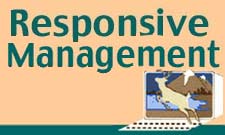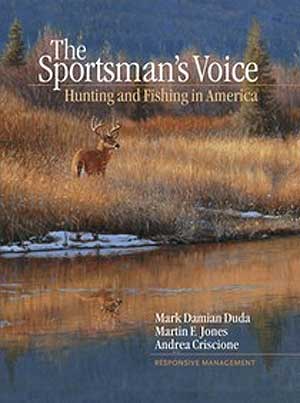The Sportsman’s Voice – New Book on Hunting and Fishing Participation, Attitudes & Policy

Harrisonburg, VA –-(Ammoland.com)- Responsive Management releases new book on hunting and fishing participation, attitudes, economics and policy in the U.S.
The book provides an in-depth understanding of the country’s sportsmen and women and reveals the important role they play in managing wildlife and protecting habitat.
A comprehensive overview of a range of hunting and fishing issues, The Sportsman’s Voice is an essential resource for anyone from policy makers to sportsmen who have a vested interest in fish and wildlife conservation in America. Understanding hunting and fishing, as well as hunters and anglers as a constituency, is vital to effectively managing the nation’s natural resources.

Recently released by Venture Publishing, The Sportsman’s Voice was coauthored by Mark Damian Duda, Martin F. Jones, and Andrea Criscione of Responsive Management, an internationally recognized survey research firm specializing in natural resource and outdoor recreation issues. The book presents numerous detailed research results from people who hunt and fish as well as the attitudes of the general public toward these activities.
“The Sportsman’s Voice is a comprehensive resource for legislators, policy makers, and other decision makers who may not have extensive backgrounds in biology or wildlife management,” said Mark Damian Duda, senior author of The Sportsman’s Voice. “This book will put critical information about the social aspects of hunting, fishing, and wildlife conservation right at their fingertips.”
Hunters and anglers also will find The Sportsman’s Voice a valuable reference tool about the policies affecting two of the most enduring pastimes in American history. Duda said he believes hunters and anglers have an obligation to know their sport.
“Healthy fish and wildlife populations in America are taken for granted today,” Duda said. “People have come to expect a diversity of wildlife in America. However, a sizable portion of the general public doesn’t consider the incredible amounts of money, time and effort sportsmen spend year in and year out to ensure the continued well-being of wildlife and our other natural resources. The truth is most of that money and effort are coming from the nation’s hunters, anglers, and fish and wildlife agencies.”
Each year, nearly 34 million Americans ages 16 and older head outdoors to hunt and fish. Through hunting and fishing license fees and excise taxes on hunting and fishing equipment, sportsmen and women are responsible for the majority of fish and wildlife conservation funding in America. Fish and wildlife management programs funded by these fees have conserved millions of acres of habitat and have restored many wildlife species, including wild turkeys, wood ducks, bald eagles, elk, white-tailed deer and pronghorn.
Members of the fish and wildlife management community have affirmed the importance of The Sportsman’s Voice as a resource for understanding the culture of hunting and fishing and communicating with American sportsmen.
“The Sportsman’s Voice is the definitive source of information regarding public attitudes toward and the economic contributions of hunting and fishing in the United States,” said Steve Williams, president of the Wildlife Management Institute and former director of the U.S. Fish and Wildlife Service. “It should be required reading for anyone truly concerned about the future of fish and wildlife conservation in our nation.”
Bob Duncan, executive director of the Virginia Department of Game and Inland Fisheries, calls the book a “must-read reference on the wildlife conservation movement in this country.”
The hunting community has embraced The Sportsman’s Voice as well.
“If, like me, you believe that quality of life is enhanced by hunting, fishing and other outdoor pastimes, then you need to pay close attention to this book,” said John Tomke, former president of Ducks Unlimited and current chairman of the Wildlife and Hunting Heritage Conservation Council.
The 259-page book has 10 chapters addressing a range of issues:
- A history of hunting, fishing, and fish and wildlife management in the United States;
- Public attitudes toward the environment, natural resources and wildlife;
- Attitudes toward hunting and fishing;
- Participation in hunting and fishing;
- Law enforcement, firearms and safety issues;
- Fish and wildlife agencies and commissions, government acts, and conservation organizations;
- Funding for hunting and fishing and the management of fish and wildlife;
- The economic significance of hunting and fishing;
- Ballot initiatives, referenda and sportsmen’s issues; and
- The future of hunting and fishing in the United States.
“The North American Model of Wildlife Conservation is the wildlife management system that has evolved in this country to become the envy of the world,” Duda said.
“As Americans, we have an obligation to understand the ways in which policy makers, legislators, fish and wildlife professionals, conservation and sportsmen’s organizations, and hunters and anglers work together to manage our natural resources. One of the most important things we wanted to demonstrate with this book is how central hunting and fishing are to that model.”
The Sportsman’s Voice: Hunting and Fishing in America, by Mark Damian Duda, Martin F. Jones, and Andrea Criscione. 259 pages. Venture Publishing. $45.95.
Responsive Management is an internationally recognized public opinion and attitude survey research firm specializing in natural resource and outdoor recreation issues. Our mission is to help natural resource and outdoor recreation agencies and organizations better understand and work with their constituents, customers, and the public. For more information about Responsive Management, visit www.responsivemanagement.com.
